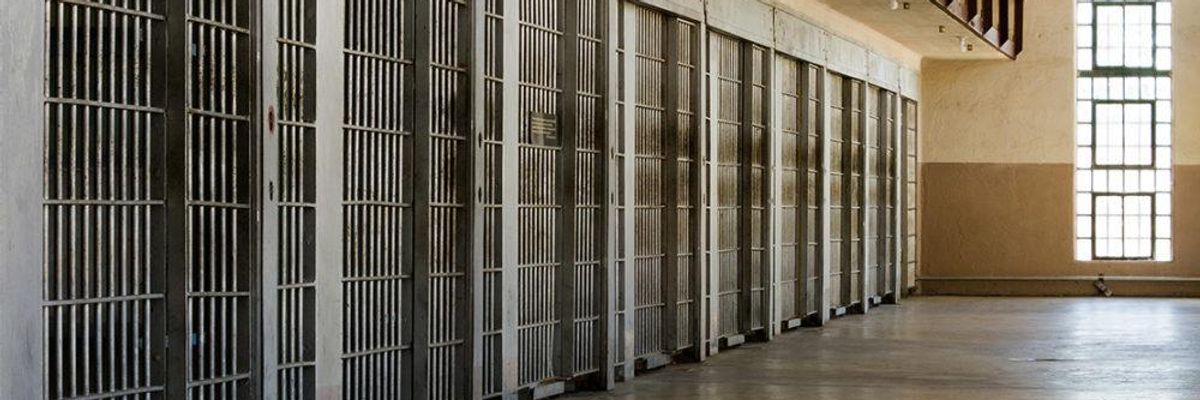
People in prisons and jails are often denied adequate soap and cleaning supplies, making infection control nearly impossible. (Photo: Shutterstock)
Are Our Prisons and Jails Ready for COVID-19?
People in prisons and jails are uniquely vulnerable to coronavirus. Officials must act quickly to pull together a plan to ensure the safety of incarcerated people, medical staff, and correctional officers.
The country and the world face a public health emergency in the new coronavirus causing COVID-19. The media is filled with concerns about how we will respond. Will we close schools? Cancel sporting events and other large gatherings? Work from home? Avoid public transportation?
But little has been said about one of the most vulnerable sectors of our population: the people in our prisons and jails. Although people often think of prisons and jails as closed environments, they are not. Medical staff, correctional staff, and visitors come from the community into the facilities every day and then return home. People are admitted to and released from prisons and jails, and they go back and forth to court and to medical appointments. There is ample opportunity for a virus to enter a prison or jail, and for it to go back out into the community.
Once a contagious illness enters, conditions in correctional facilities are highly conducive to it spreading. People in prisons and jails live in close proximity to each other. Many are housed in large dormitories, sharing the same space. Even where people are housed in cells, the ventilation is often inadequate. People in prisons and jails are often denied adequate soap and cleaning supplies, making infection control nearly impossible.
Many people in prisons and jails are in relatively poor health and suffer from serious chronic conditions due to lack of access to healthcare in the community, or abysmal healthcare in the correctional system. While people sent to prisons and jails tend to be young, the harsh sentencing policies of recent decades mean that the prison population is aging. Medical staff are generally stretched thin even in the best of times. Though incarcerated people have a constitutional right to adequate medical and mental health care, the reality is they too often do not have access to it.
All this means that prison and jail populations are extremely vulnerable to a contagious illness like COVID-19. Moreover, prisoners have fewer options for protecting themselves and others. They don't have the option to stay away from other people when they are sick. They can ask for medical attention, but prisons and jails have few infirmary beds and fewer rooms for medical isolation.
If medical staff become ill or have to be quarantined, there will be even fewer people available to provide care. If correctional staff become ill or need to be quarantined, there will be fewer officers available to bring sick people to hospitals, to the infirmary, and even just to keep an eye on who in the facility is showing signs of illness.
To limit outbreaks of COVID-19 in jails and prisons, officials must act, and they must act quickly. They should coordinate with local public health officials to determine the most appropriate measures to take, given the local conditions and the peculiarities of the correctional environment. While the plans will differ from facility to facility, there are points that should be addressed in any plan:
- How will all people in the facility -- incarcerated people, staff, and visitors -- be educated so they can understand the risks, protect themselves, and protect others? This will ideally be operationalized and conducted at scale.
- Under what circumstances will staff and people incarcerated in the facilities be tested for the virus? How many tests are needed?
- If people who are incarcerated require quarantine and/or treatment, how will that be accomplished?
- If medical staff must be quarantined or become ill, how will the facility monitor, quarantine and treat the prison or jail population?
- If correctional staff must be quarantined or become ill, how will the facility operate, both in terms of addressing the virus and in terms of simply maintaining necessary services, safety, and security?
- If incarcerated people must be quarantined or become ill, how will the facility continue necessary operations that are reliant on the prison or jail population, such as food preparation?
- Are there particularly vulnerable populations, such as the elderly, or immunocompromised, and how can they be protected?
- How will the facility meet the challenges of COVID-19 without violating the rights of the people in its custody?
People in government custody, including in prisons, jails, and civil detention, are often forgotten in emergencies. This creates unnecessary suffering and loss of life. We have the opportunity to take steps now to limit the spread of the virus in prisons, jails, and detention centers. But the time to act for the health of those incarcerated, and for the broader community, is now.
An Urgent Message From Our Co-Founder
Dear Common Dreams reader, The U.S. is on a fast track to authoritarianism like nothing I've ever seen. Meanwhile, corporate news outlets are utterly capitulating to Trump, twisting their coverage to avoid drawing his ire while lining up to stuff cash in his pockets. That's why I believe that Common Dreams is doing the best and most consequential reporting that we've ever done. Our small but mighty team is a progressive reporting powerhouse, covering the news every day that the corporate media never will. Our mission has always been simple: To inform. To inspire. And to ignite change for the common good. Now here's the key piece that I want all our readers to understand: None of this would be possible without your financial support. That's not just some fundraising cliche. It's the absolute and literal truth. We don't accept corporate advertising and never will. We don't have a paywall because we don't think people should be blocked from critical news based on their ability to pay. Everything we do is funded by the donations of readers like you. Will you donate now to help power the nonprofit, independent reporting of Common Dreams? Thank you for being a vital member of our community. Together, we can keep independent journalism alive when it’s needed most. - Craig Brown, Co-founder |
The country and the world face a public health emergency in the new coronavirus causing COVID-19. The media is filled with concerns about how we will respond. Will we close schools? Cancel sporting events and other large gatherings? Work from home? Avoid public transportation?
But little has been said about one of the most vulnerable sectors of our population: the people in our prisons and jails. Although people often think of prisons and jails as closed environments, they are not. Medical staff, correctional staff, and visitors come from the community into the facilities every day and then return home. People are admitted to and released from prisons and jails, and they go back and forth to court and to medical appointments. There is ample opportunity for a virus to enter a prison or jail, and for it to go back out into the community.
Once a contagious illness enters, conditions in correctional facilities are highly conducive to it spreading. People in prisons and jails live in close proximity to each other. Many are housed in large dormitories, sharing the same space. Even where people are housed in cells, the ventilation is often inadequate. People in prisons and jails are often denied adequate soap and cleaning supplies, making infection control nearly impossible.
Many people in prisons and jails are in relatively poor health and suffer from serious chronic conditions due to lack of access to healthcare in the community, or abysmal healthcare in the correctional system. While people sent to prisons and jails tend to be young, the harsh sentencing policies of recent decades mean that the prison population is aging. Medical staff are generally stretched thin even in the best of times. Though incarcerated people have a constitutional right to adequate medical and mental health care, the reality is they too often do not have access to it.
All this means that prison and jail populations are extremely vulnerable to a contagious illness like COVID-19. Moreover, prisoners have fewer options for protecting themselves and others. They don't have the option to stay away from other people when they are sick. They can ask for medical attention, but prisons and jails have few infirmary beds and fewer rooms for medical isolation.
If medical staff become ill or have to be quarantined, there will be even fewer people available to provide care. If correctional staff become ill or need to be quarantined, there will be fewer officers available to bring sick people to hospitals, to the infirmary, and even just to keep an eye on who in the facility is showing signs of illness.
To limit outbreaks of COVID-19 in jails and prisons, officials must act, and they must act quickly. They should coordinate with local public health officials to determine the most appropriate measures to take, given the local conditions and the peculiarities of the correctional environment. While the plans will differ from facility to facility, there are points that should be addressed in any plan:
- How will all people in the facility -- incarcerated people, staff, and visitors -- be educated so they can understand the risks, protect themselves, and protect others? This will ideally be operationalized and conducted at scale.
- Under what circumstances will staff and people incarcerated in the facilities be tested for the virus? How many tests are needed?
- If people who are incarcerated require quarantine and/or treatment, how will that be accomplished?
- If medical staff must be quarantined or become ill, how will the facility monitor, quarantine and treat the prison or jail population?
- If correctional staff must be quarantined or become ill, how will the facility operate, both in terms of addressing the virus and in terms of simply maintaining necessary services, safety, and security?
- If incarcerated people must be quarantined or become ill, how will the facility continue necessary operations that are reliant on the prison or jail population, such as food preparation?
- Are there particularly vulnerable populations, such as the elderly, or immunocompromised, and how can they be protected?
- How will the facility meet the challenges of COVID-19 without violating the rights of the people in its custody?
People in government custody, including in prisons, jails, and civil detention, are often forgotten in emergencies. This creates unnecessary suffering and loss of life. We have the opportunity to take steps now to limit the spread of the virus in prisons, jails, and detention centers. But the time to act for the health of those incarcerated, and for the broader community, is now.
The country and the world face a public health emergency in the new coronavirus causing COVID-19. The media is filled with concerns about how we will respond. Will we close schools? Cancel sporting events and other large gatherings? Work from home? Avoid public transportation?
But little has been said about one of the most vulnerable sectors of our population: the people in our prisons and jails. Although people often think of prisons and jails as closed environments, they are not. Medical staff, correctional staff, and visitors come from the community into the facilities every day and then return home. People are admitted to and released from prisons and jails, and they go back and forth to court and to medical appointments. There is ample opportunity for a virus to enter a prison or jail, and for it to go back out into the community.
Once a contagious illness enters, conditions in correctional facilities are highly conducive to it spreading. People in prisons and jails live in close proximity to each other. Many are housed in large dormitories, sharing the same space. Even where people are housed in cells, the ventilation is often inadequate. People in prisons and jails are often denied adequate soap and cleaning supplies, making infection control nearly impossible.
Many people in prisons and jails are in relatively poor health and suffer from serious chronic conditions due to lack of access to healthcare in the community, or abysmal healthcare in the correctional system. While people sent to prisons and jails tend to be young, the harsh sentencing policies of recent decades mean that the prison population is aging. Medical staff are generally stretched thin even in the best of times. Though incarcerated people have a constitutional right to adequate medical and mental health care, the reality is they too often do not have access to it.
All this means that prison and jail populations are extremely vulnerable to a contagious illness like COVID-19. Moreover, prisoners have fewer options for protecting themselves and others. They don't have the option to stay away from other people when they are sick. They can ask for medical attention, but prisons and jails have few infirmary beds and fewer rooms for medical isolation.
If medical staff become ill or have to be quarantined, there will be even fewer people available to provide care. If correctional staff become ill or need to be quarantined, there will be fewer officers available to bring sick people to hospitals, to the infirmary, and even just to keep an eye on who in the facility is showing signs of illness.
To limit outbreaks of COVID-19 in jails and prisons, officials must act, and they must act quickly. They should coordinate with local public health officials to determine the most appropriate measures to take, given the local conditions and the peculiarities of the correctional environment. While the plans will differ from facility to facility, there are points that should be addressed in any plan:
- How will all people in the facility -- incarcerated people, staff, and visitors -- be educated so they can understand the risks, protect themselves, and protect others? This will ideally be operationalized and conducted at scale.
- Under what circumstances will staff and people incarcerated in the facilities be tested for the virus? How many tests are needed?
- If people who are incarcerated require quarantine and/or treatment, how will that be accomplished?
- If medical staff must be quarantined or become ill, how will the facility monitor, quarantine and treat the prison or jail population?
- If correctional staff must be quarantined or become ill, how will the facility operate, both in terms of addressing the virus and in terms of simply maintaining necessary services, safety, and security?
- If incarcerated people must be quarantined or become ill, how will the facility continue necessary operations that are reliant on the prison or jail population, such as food preparation?
- Are there particularly vulnerable populations, such as the elderly, or immunocompromised, and how can they be protected?
- How will the facility meet the challenges of COVID-19 without violating the rights of the people in its custody?
People in government custody, including in prisons, jails, and civil detention, are often forgotten in emergencies. This creates unnecessary suffering and loss of life. We have the opportunity to take steps now to limit the spread of the virus in prisons, jails, and detention centers. But the time to act for the health of those incarcerated, and for the broader community, is now.

